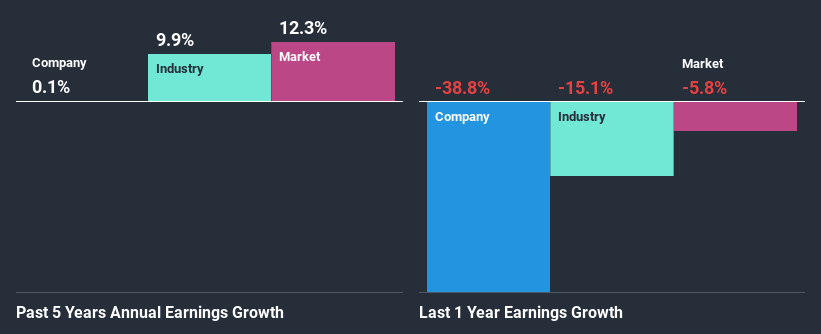Are Young & Co.'s Brewery, P.L.C.'s (LON:YNGA) Mixed Financials Driving The Negative Sentiment?

It is hard to get excited after looking at Young's Brewery's (LON:YNGA) recent performance, when its stock has declined 15% over the past three months. It is possible that the markets have ignored the company's differing financials and decided to lean-in to the negative sentiment. Fundamentals usually dictate market outcomes so it makes sense to study the company's financials. In this article, we decided to focus on Young's Brewery's ROE.
Return on equity or ROE is an important factor to be considered by a shareholder because it tells them how effectively their capital is being reinvested. Simply put, it is used to assess the profitability of a company in relation to its equity capital.
See our latest analysis for Young's Brewery
How Is ROE Calculated?
Return on equity can be calculated by using the formula:
Return on Equity = Net Profit (from continuing operations) ÷ Shareholders' Equity
So, based on the above formula, the ROE for Young's Brewery is:
3.3% = UK£19m ÷ UK£591m (Based on the trailing twelve months to March 2020).
The 'return' is the profit over the last twelve months. Another way to think of that is that for every £1 worth of equity, the company was able to earn £0.03 in profit.
What Is The Relationship Between ROE And Earnings Growth?
Thus far, we have learned that ROE measures how efficiently a company is generating its profits. We now need to evaluate how much profit the company reinvests or "retains" for future growth which then gives us an idea about the growth potential of the company. Generally speaking, other things being equal, firms with a high return on equity and profit retention, have a higher growth rate than firms that don’t share these attributes.
Young's Brewery's Earnings Growth And 3.3% ROE
At first glance, Young's Brewery's ROE doesn't look very promising. A quick further study shows that the company's ROE doesn't compare favorably to the industry average of 9.5% either. Therefore, Young's Brewery's flat earnings over the past five years can possibly be explained by the low ROE amongst other factors.
As a next step, we compared Young's Brewery's net income growth with the industry and were disappointed to see that the company's growth is lower than the industry average growth of 9.9% in the same period.
The basis for attaching value to a company is, to a great extent, tied to its earnings growth. It’s important for an investor to know whether the market has priced in the company's expected earnings growth (or decline). Doing so will help them establish if the stock's future looks promising or ominous. If you're wondering about Young's Brewery's's valuation, check out this gauge of its price-to-earnings ratio, as compared to its industry.
Is Young's Brewery Using Its Retained Earnings Effectively?
Despite having a normal three-year median payout ratio of 32% (implying that the company keeps 68% of its income) over the last three years, Young's Brewery has seen a negligible amount of growth in earnings as we saw above. So there could be some other explanation in that regard. For instance, the company's business may be deteriorating.
Based on the latest analysts' estimates, we found that the company's future payout ratio over the next three years is expected to hold steady at 31%. Regardless, the future ROE for Young's Brewery is predicted to rise to 5.5% despite there being not much change expected in its payout ratio.
Conclusion
On the whole, we feel that the performance shown by Young's Brewery can be open to many interpretations. Even though it appears to be retaining most of its profits, given the low ROE, investors may not be benefitting from all that reinvestment after all. The low earnings growth suggests our theory correct. With that said, the latest industry analyst forecasts reveal that the company's earnings are expected to accelerate. To know more about the company's future earnings growth forecasts take a look at this free report on analyst forecasts for the company to find out more.
This article by Simply Wall St is general in nature. It does not constitute a recommendation to buy or sell any stock, and does not take account of your objectives, or your financial situation. We aim to bring you long-term focused analysis driven by fundamental data. Note that our analysis may not factor in the latest price-sensitive company announcements or qualitative material. Simply Wall St has no position in any stocks mentioned.
Have feedback on this article? Concerned about the content? Get in touch with us directly. Alternatively, email editorial-team@simplywallst.com.

 Yahoo Finance
Yahoo Finance 
